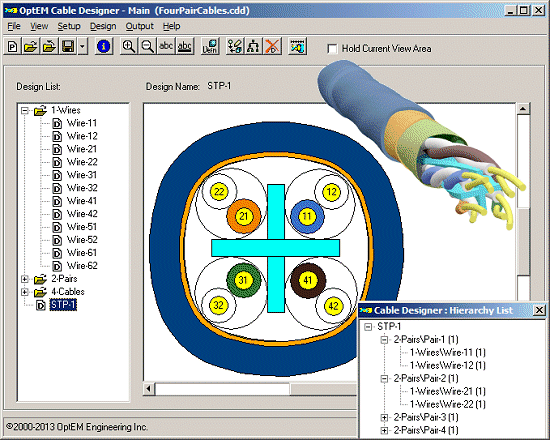OptEM Cable Designer – Copper Cable Design, Modeling and Analysis Software
OptEM Cable Designer
OptEM Cable Designer
OptEM Cable Designer is an accurate and cost effective software tool used for designing and simulating the performance of all types of copper cables. In particular, the software investigates the performance of unshielded twisted-pair (UTP), twisted-pair cables (TPC), quad, ribbon, subsea umbilical and specialty cables, as well as flex circuits from DC to 10 GHz.

Product Description
OptEM Cable Designer extrudes a 3D model of the cable taking into account lay lengths and realistic shapes of enclosures. Then an electromagnetic (EM) field analysis is performed to extract L, R, C, G parameters of selected pairs as a function of frequency and location along the cable. Further analysis produces S-parameter output which can be presented in the form of insertion loss, return loss, NEXT and FEXT plots. Using the software, cable design engineers are able to assess their designs in a timely and productive way by reducing the number of prototypes and ultimately the cost of cable production.
Hierarchical Design
OptEM Cable Designer uses a hierarchical design concept where existing design elements are used as building blocks (instances) in constructing higher level designs. Objects in the cross section are tagged to identify key properties including the core material (conductor or dielectric), plating material and thickness, on-screen color representation, and the object name.
In addition, each design element has unique position, rotation and lay length properties which allow individual twisting of pairs and bundles in the cable. Cable geometry is extruded automatically from a single cross section using twisting, backtwisting, collapsing and enclosure shaping algorithms.
The hierarchical design concept, including object tagging and design element position, rotation and lay length details, allow the cable-design engineer to quickly and easily model complex cable geometries.
Electromagnetic Modeling
OptEM Cable Designer's accuracy is ensured by the built-in EM field solver which is based on the Helmholtz equation and, unlike static field solvers, analyzes high frequency skin and proximity effects in wires, eddy currents in shields, and dielectric losses in insulation. Frequency dependent data is also incorporated by identifying variations in material properties at different frequencies.
Signal Integrity Results
Results produced by the software are in excellent correlation to measured results and include S-parameter output such as FEXT, NEXT and RL, plus text reports with transmission parameters, attenuation, characteristic impedance and more. Combined with 3D viewing, W-element SPICE models, temperature variation analysis and a measurement modification facility for back annotation of measurement data, OptEM Cable Designer is a powerful and effective tool for modeling cables.

Features & Benefits
Features
- uses a hierarchical design concept
- allows each multi-conductor cable instance within the hierarchy to have its own position, rotation and lay length
- defines object properties which include core material (conductor or dielectric), plating material and thickness, and on-screen color representation
- tags object properties bundled as a single object definition to a selected shape
- performs frequency-dependent electromagnetic field analysis and generates L, R, C, G reports and transmission line models including the W-element SPICE model
- runs EM field solver in batch mode
- outputs S-parameters including insertion loss, return loss, FEXT and NEXT
- offers 3D viewing capability, temperature variation analysis, and measurement modification facility for back annotation of measurement data
Benefits
- designers can quickly and easily model high-performance multi-conductor cable configurations
- detailed modeling properties provide real-world cable geometries for accurate simulation
- frequency dependent EM field solver takes into account dielectric and conductor losses, including proximity and skin effects and eddy currents in shields inherent in today's cable structures
- inclusion of losses in the EM field analysis provides accurate L, R, C, G reports and transmission line models
- S-parameter output such as insertion loss, return loss, FEXT and NEXT allow cable-design engineers to make reasonable assessments of cable signal integrity
- designers can easily adjust and modify cable properties and geometry to re-simulate
- cable manufacturers can reduce the number of prototypes and ultimately the cost of cable production
